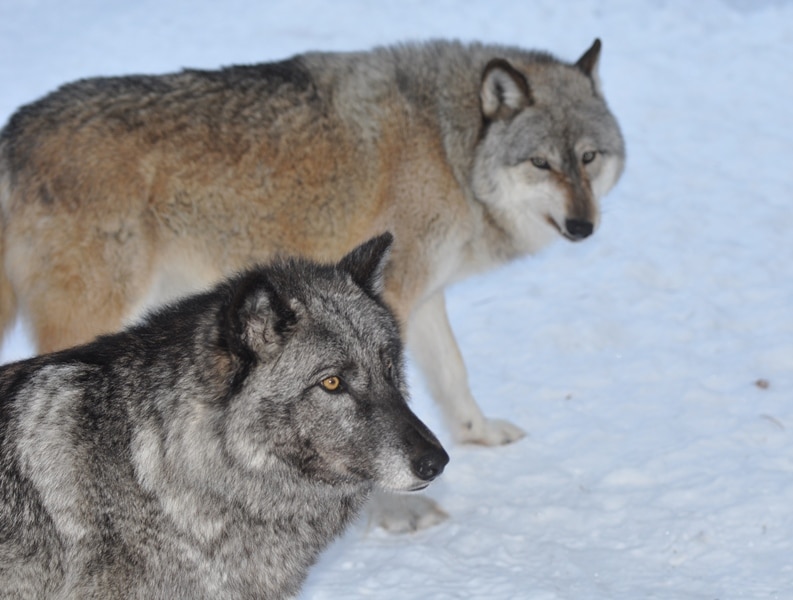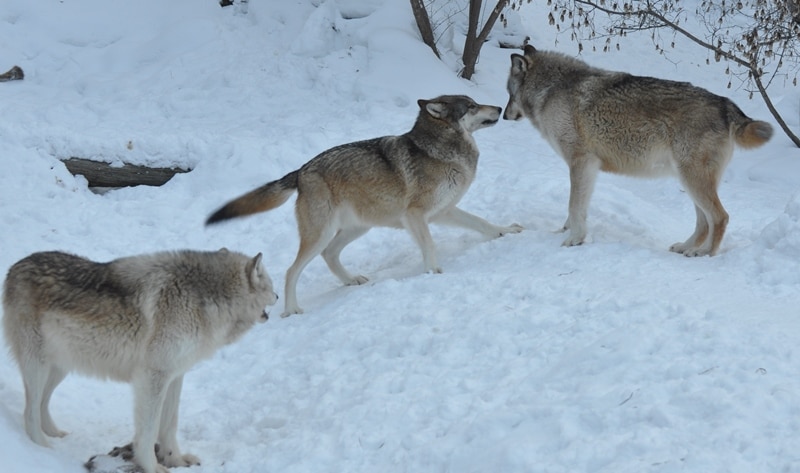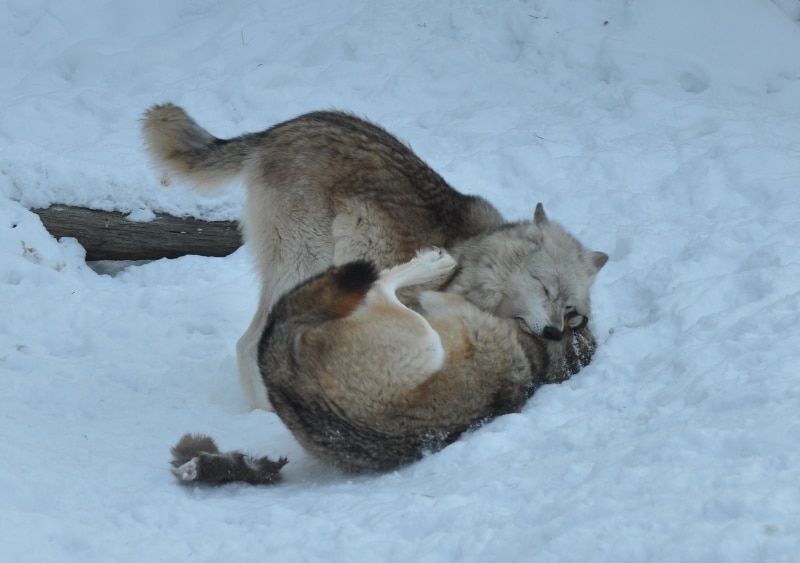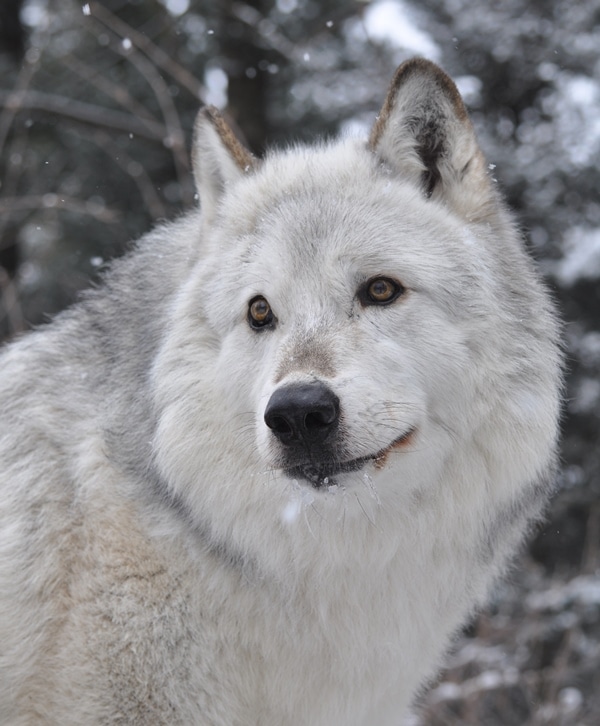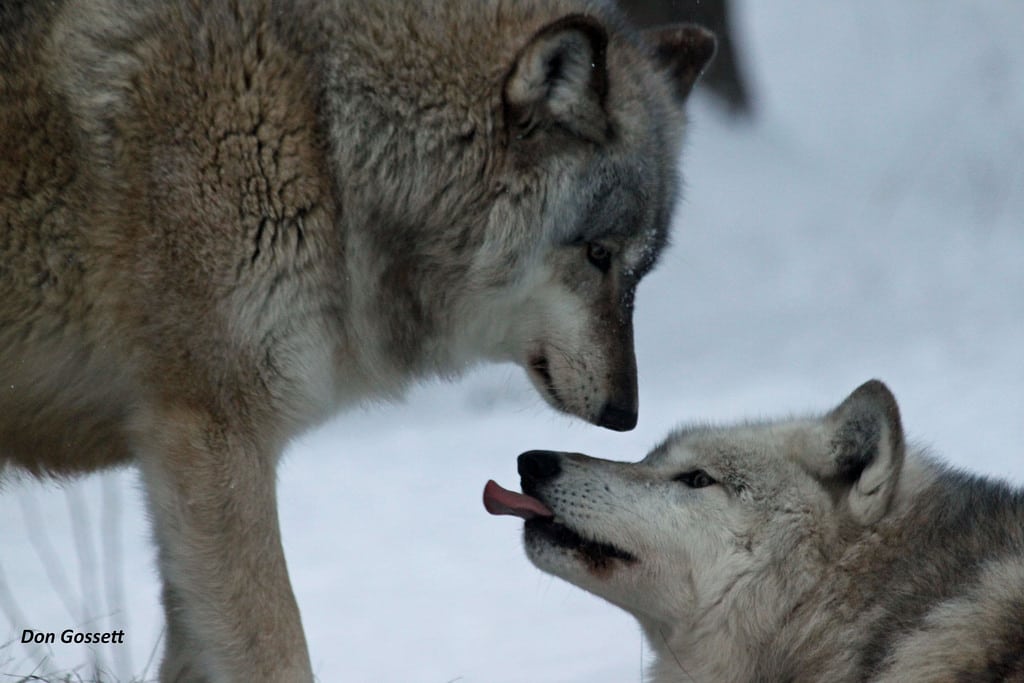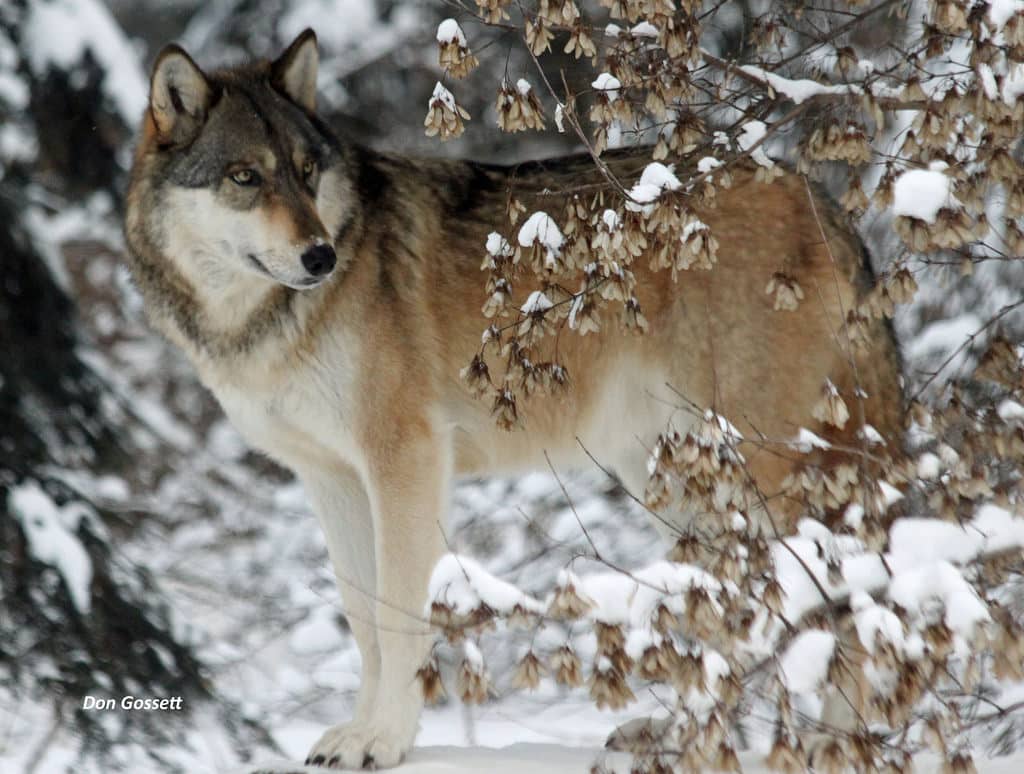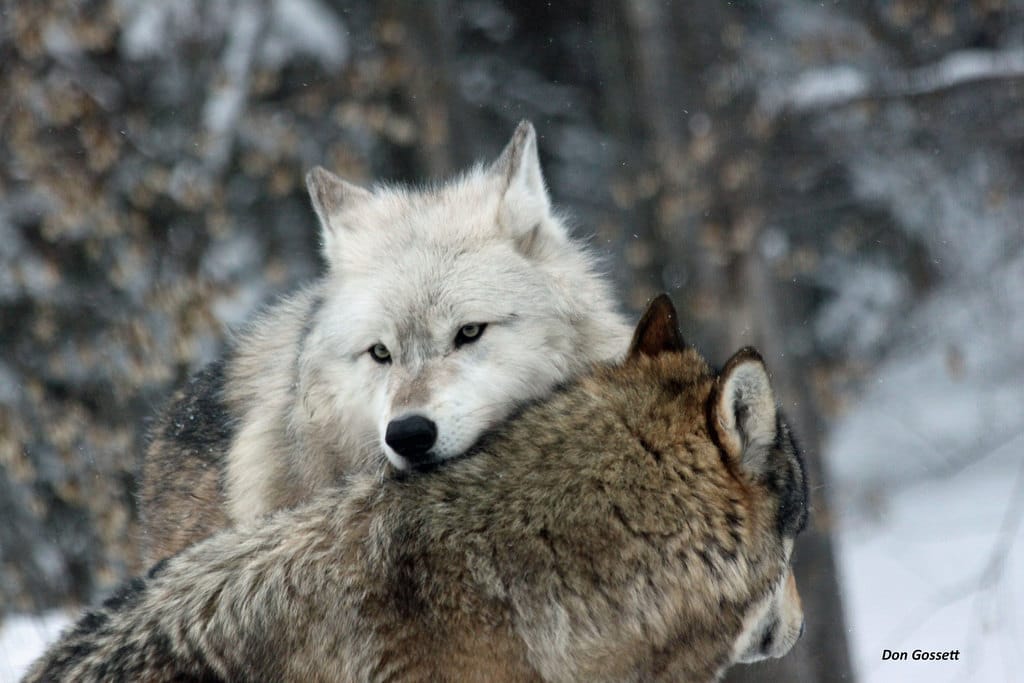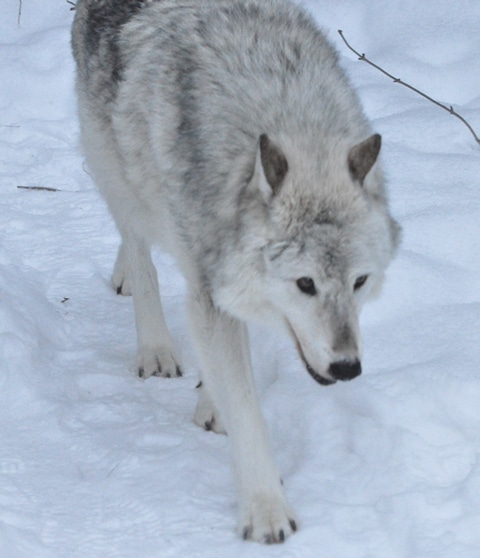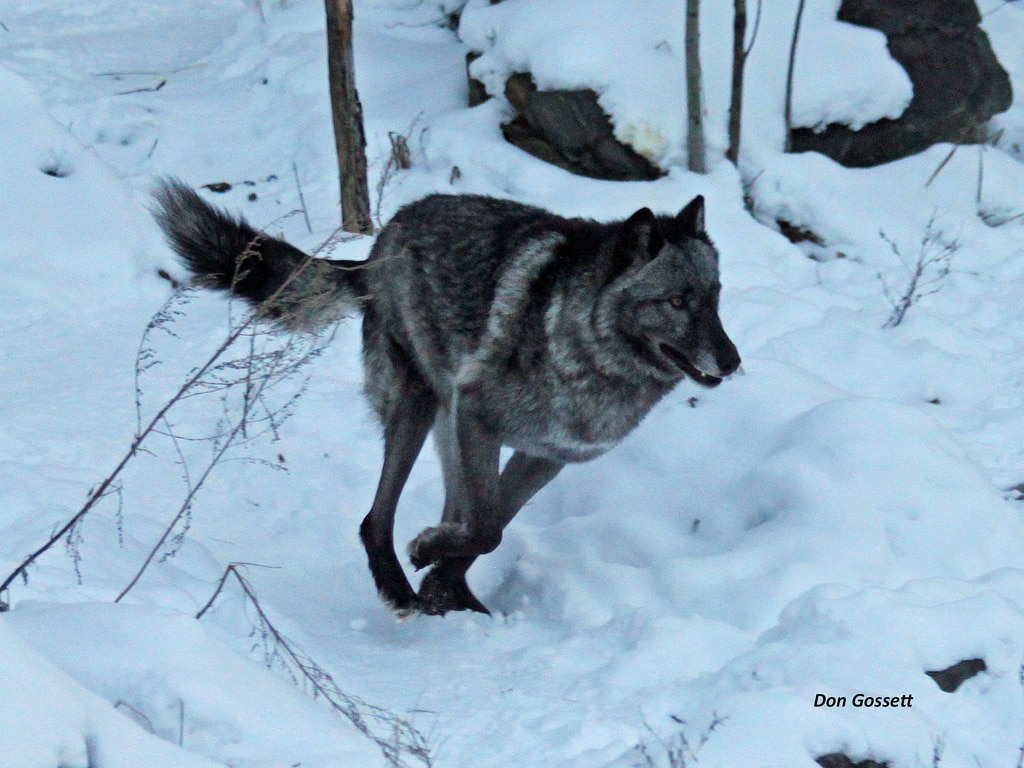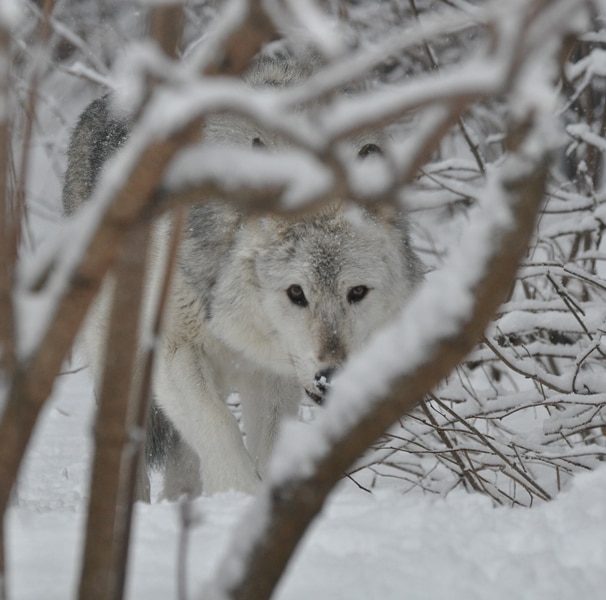In the world of Ethology (the study of animal behavior), there are many debates about the influence of individual personalities, especially with a social pack animal like the wolf. One of the challenges we face is to interpret behavior without becoming anthropomorphic (using human terms to describe animal behavior). In this photo, Aidan seems to be expressing a particular thought towards Luna. There are days where the “pair-bonding” behavior between the dominant pack leaders is not quite evident.
Archives
Boltz is displaying a T-2 tail posture that indicates a more assertive posture, whether it be related to dominance, predatory or investigation behavior. The mixed signal is in Boltz’s ear posture. While his tail shows assertive behavior, his ears are pricked and turned sideways, usually an indication of tension. The other notable postures in this photo is that Aidan is standing tall, his ears are also pricked and turned sideways, with a slight wag to his T-2 Tail. Our interpretation of this response is that he’s facing off with Boltz and confronting Boltz’s display, but there’s a slight anxiety about the interaction show in the ear posture and tail wag. It’s been our experience with the testing of previous pack leaders, that these subtle behaviors can be important when predicting the loss of confidence in a dominant wolf.
Since the new Wolf Care Center construction is in full swing, there seems to be a slight increase in Aidan’s dominance over Denali, and subsequently, Denali’s redirection to Boltz. While overall, the wolves have done well with the construction, any prolonged change in the surrounding environment can impact pack behavior. In this week’s photo, Denali is forcing Boltz into a submissive posture with a behavior we identify as “Squash”, while Boltz struggles to break free. You may be familiar with this behavior from observing Luna, she frequently displays this behavior to acquire possessions from her larger pack mates. Notice that Aidan isn’t in the photo, this open display of status would not likely be tolerated by Aidan.
The addition of the new Wolf Care Center adjacent to the wolf lab will be a tremendous benefit for the pups as well as for our retirees, but for Grizzer, the anticipation for a return to normalcy is getting to be too much. When wolf care staff enter the east side vestibule, he looks for opportunities to check out the construction personally by slipping through a gate. Of course, we are not ready for his return, but hope to have him back in the action by the end of March. One good thing about his impatient behavior is that he is reminding wolf care staff about the importance of gate protocol. That reminder is a necessity when socializing young pups.
This has been a challenging winter season for the Exhibit Pack. We have had years of concern for Aidan’s physical issues with his diagnosis of an auto-immune disorder, then we met another challenge with his digestive system this fall. Both of these medical conditions seem to be under control with our treatment choices, but we know that Aidan is showing his age and there’s a 4-year old wolf watching his every move. No doubt, we were concerned when we started a construction project in February, which is the height of the winter dominance, but we couldn’t wait on the Wolf Care Center expansion, it’s potential to improve the lives of our ambassadors is too important. So, we watched, fed extra food resources as distractions and made sure that Aidan had staff attention first. All of these efforts were necessary to maintain his confidence. Our efforts seem to have worked, as this photo demonstrates Aidan’s dominant status and Denali shows his active submission. Our goal was to get this pack through the winter season with no change in leadership. Aidan is a great dominant male and an excellent leader for pups. We know there will come a time when he loses confidence, but it doesn’t appear that will happen in this winter season.
In previous logs, we have referenced the importance of body postures to indicate a wolf’s attitude. We are particularly interested when these body postures represent an alert and focused lower ranking wolf. Boltz will be turning 4 years of age in March and so far, he has been somewhat reserved when posturing for status. This doesn’t mean that he isn’t always watching for opportunities and can take advantage of another vulnerable wolf, but at this point, his timid personality trait prevails. Of course as a science driven organization, we are always interested in the nature versus nurture debate. We know that wolves respond differently to changes in their environment. When the construction of the new Wolf Care Center started, the dominant wolves seemed to be more anxious about the work than the lower ranking wolves. In this photo, Boltz is alert to the activity displaying ears pricked forward, but the tail is in a T-3 or relaxed position. Maybe if you’re at the bottom of the pack order, there isn’t much concern about external distractions, but when your at the to top, it’s just one more thing to test your position.
Denali is demonstrating a chin rest on Boltz, but his ears pricked to the side don’t demonstrate a lot of confidence in his actions. If you look at Boltz’s ears, he doesn’t display a lot of confidence in the behavioral interaction either. This is the dynamics between a subordinate male (Boltz) and a passive second ranking male (Denali). Denali never really displays behaviors to increase his rank. He seems to be comfortable being subordinate to his dominant pack mate, Aidan. But, when Boltz started showing an interest in climbing rank, Denali appeared to reluctantly show some status. Fortunately for Denali, Boltz has a timid behavior seems to go with the flow. Will two more male pups change this dynamic? Not likely until they reach maturity around 18 – 24 months of age, by then, Denali and Aidan will be getting ready for retirement.
In the the Center’s Ethogram (behavioral dictionary), we code body postures to help interpret behaviors. One of the codes is EPTS, which means, Ears Pricked and Turned Sideways. When the Wolf Care Center construction began, Grizzer showed a lot of anxiety and we decided to help him through the anxious times with a mild sedative, daily food distractions and a good layer of cover hay to find a comfortable place to watch the action. This combination seems to have worked and while he shows anxiety by pricking his ears sideways, he shows interest in that the ears are still pricked in an alert fashion. Wolf Care Staff need to be very cognitive of all the subtle details that might express anxiety, especially when socializing pups.
When we met Luna and began to discover her medical needs, we weren’t certain of her future as a pack member and her ability to keep up with 130 lb. packmates. Thanks to the care of our Vet Care team, the many donations of hip and joint supplements through our Amazon Wish List and the tenacity of this particular wolf, Luna is an active pack member. She once again has managed a winter, admittedly a mild one, but she had a few -25 below challenges and she did well. As she approaches her 4th year of age, we see no indication of her slowing down or starting to act like a mature adult. Of course, two young pups might give her the stimuli to show a more mature, reserved side.
We have some great news!!! The Wolf Care Center expansion and upgrades will begin within the next few weeks. We are so excited to have this work completed, not only for our new pups arriving later this spring, but also for the potential care it will provide for our aging wolves. The new building will have a direct connection to the Pack Holding Area, with an access door that allows the wolves to enter the heated (and cooled) space of a building directly from their outdoor enclosure. We can’t wait to share this with Grizzer, who already spends a fair amount of time staring at the lab door trying to figure out the day to day activities of the Wolf Care Staff. Due to the excavation work, we will be disconnecting Grizzer’s camera during the construction and Grizzer will be moving solely to the East Side Retired Enclosure. Don’t worry, we will try to add additional footage of Grizzer and the construction on Youtube. When the construction is completed, we intend to install a new camera viewing Grizzer’s densite as well as share his experiences accessing the lab.

The International Wolf Center uses science-based education to teach and inspire the world about wolves, their ecology, and the wolf-human relationship.

